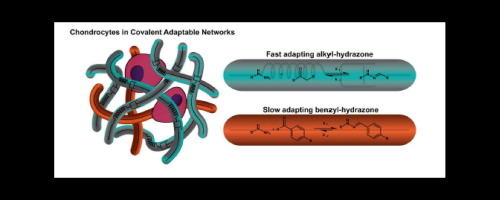当前位置:
X-MOL 学术
›
Acta Biomater.
›
论文详情
Our official English website, www.x-mol.net, welcomes your
feedback! (Note: you will need to create a separate account there.)
Hydrazone covalent adaptable networks modulate extracellular matrix deposition for cartilage tissue engineering.
Acta Biomaterialia ( IF 9.4 ) Pub Date : 2018-11-10 , DOI: 10.1016/j.actbio.2018.11.014 Benjamin M Richardson 1 , Daniel G Wilcox 2 , Mark A Randolph 3 , Kristi S Anseth 1
Acta Biomaterialia ( IF 9.4 ) Pub Date : 2018-11-10 , DOI: 10.1016/j.actbio.2018.11.014 Benjamin M Richardson 1 , Daniel G Wilcox 2 , Mark A Randolph 3 , Kristi S Anseth 1
Affiliation

|
Cartilage tissue engineering strategies often rely on hydrogels with fixed covalent crosslinks for chondrocyte encapsulation, yet the resulting material properties are largely elastic and can impede matrix deposition. To address this limitation, hydrazone crosslinked poly(ethylene glycol) hydrogels were formulated to achieve tunable viscoelastic properties and to study how chondrocyte proliferation and matrix deposition vary with the time-dependent material properties of covalent adaptable networks. Hydrazone equilibrium differences were leveraged to produce average stress relaxation times from hours (4.01 × 103 s) to months (2.78 × 106 s) by varying the percentage of alkyl-hydrazone (aHz) and benzyl-hydrazone (bHz) crosslinks. Swelling behavior and degradation associated with adaptability were characterized to quantify temporal network changes that can influence the behavior of encapsulated chondrocytes. After four weeks, mass swelling ratios varied from 36 ± 3 to 17 ± 0.4 and polymer retention ranged from 46 ± 4% to 92 ± 5%, with higher aHz content leading to loss of network connectivity with time. Hydrogels were formulated near the Flory-Stockmayer bHz percolation threshold (17% bHz) to investigate chondrocyte response to distinct levels of covalent architecture adaptability. Four weeks post-encapsulation, formulations with average relaxation times of 3 days (2.6 × 105s) revealed increased cellularity and an interconnected articular cartilage-specific matrix. Chondrocytes embedded in this adaptable formulation (22% bHz) deposited 190 ± 30% more collagen and 140 ± 20% more sulfated glycosaminoglycans compared to the 100% bHz control, which constrained matrix deposition to pericellular space. Collectively, these findings indicate that incorporating highly adaptable aHz crosslinks enhanced regenerative outcomes. However, connected networks containing more stable bHz bonds were required to achieve the highest quality neocartilaginous tissue. STATEMENT OF SIGNIFICANCE: Covalently crosslinked hydrogels provide robust mechanical support for cartilage tissue engineering applications in articulating joints. However, these materials traditionally demonstrate purely elastic responses to deformation despite the dynamic viscoelastic properties of native cartilage tissue. Here, we present hydrazone poly(ethylene glycol) hydrogels with tunable viscoelastic properties and study covalent adaptable networks for cartilage tissue engineering. Using hydrazone equilibrium and Flory-Stockmayer theory we identified average relaxation times leading to enhanced regenerative outcomes and showed that extracellular matrix deposition was biphasic as a function of the hydrazone covalent adaptability. We also showed that the incorporation of highly adaptable covalent crosslinks could improve cellularity of neotissue, but that a percolating network of more stable bonds was required to maintain scaffold integrity and form the highest quality neocartilaginous tissue.
中文翻译:

腙共价适应性网络调节软骨组织工程的细胞外基质沉积。
软骨组织工程策略通常依赖于具有固定共价交联的水凝胶来封装软骨细胞,但所得材料特性很大程度上是弹性的,会阻碍基质沉积。为了解决这一限制,我们配制了腙交联聚乙二醇水凝胶,以实现可调节的粘弹性特性,并研究软骨细胞增殖和基质沉积如何随共价适应性网络的时间依赖性材料特性而变化。通过改变烷基腙 (aHz) 和苄基腙 (bHz) 交联的百分比,利用腙平衡差异产生从数小时 (4.01 × 103 s) 到数月 (2.78 × 106 s) 的平均应力松弛时间。与适应性相关的肿胀行为和退化被表征为量化可能影响封装软骨细胞行为的时间网络变化。四周后,质量膨胀比从 36 ± 3 变化到 17 ± 0.4,聚合物保留范围从 46 ± 4% 到 92 ± 5%,较高的 aHz 含量导致网络连接随着时间的推移而丧失。在 Flory-Stockmayer bHz 渗滤阈值 (17% bHz) 附近配制水凝胶,以研究软骨细胞对不同水平的共价结构适应性的反应。封装后 4 周,平均松弛时间为 3 天(2.6 × 105 秒)的制剂显示出细胞结构增加和相互连接的关节软骨特异性基质。与 100% bHz 对照相比,嵌入这种适应性配方 (22% bHz) 的软骨细胞沉积了 190 ± 30% 多的胶原蛋白和 140 ± 20% 多的硫酸化糖胺聚糖,从而限制了基质沉积到细胞周围空间。 总的来说,这些发现表明,结合高度适应性的 aHz 交联可以增强再生结果。然而,需要包含更稳定的 bHz 键的连接网络才能获得最高质量的新软骨组织。意义声明:共价交联水凝胶为关节中的软骨组织工程应用提供强大的机械支撑。然而,尽管天然软骨组织具有动态粘弹性特性,但这些材料传统上表现出对变形的纯弹性响应。在这里,我们提出了具有可调粘弹性的腙聚乙二醇水凝胶,并研究了用于软骨组织工程的共价适应性网络。利用腙平衡和 Flory-Stockmayer 理论,我们确定了导致再生结果增强的平均弛豫时间,并表明细胞外基质沉积是双相的,与腙共价适应性有关。我们还表明,高度适应性的共价交联的结合可以改善新组织的细胞结构,但需要更稳定的键的渗透网络来维持支架完整性并形成最高质量的新软骨组织。
更新日期:2018-11-10
中文翻译:

腙共价适应性网络调节软骨组织工程的细胞外基质沉积。
软骨组织工程策略通常依赖于具有固定共价交联的水凝胶来封装软骨细胞,但所得材料特性很大程度上是弹性的,会阻碍基质沉积。为了解决这一限制,我们配制了腙交联聚乙二醇水凝胶,以实现可调节的粘弹性特性,并研究软骨细胞增殖和基质沉积如何随共价适应性网络的时间依赖性材料特性而变化。通过改变烷基腙 (aHz) 和苄基腙 (bHz) 交联的百分比,利用腙平衡差异产生从数小时 (4.01 × 103 s) 到数月 (2.78 × 106 s) 的平均应力松弛时间。与适应性相关的肿胀行为和退化被表征为量化可能影响封装软骨细胞行为的时间网络变化。四周后,质量膨胀比从 36 ± 3 变化到 17 ± 0.4,聚合物保留范围从 46 ± 4% 到 92 ± 5%,较高的 aHz 含量导致网络连接随着时间的推移而丧失。在 Flory-Stockmayer bHz 渗滤阈值 (17% bHz) 附近配制水凝胶,以研究软骨细胞对不同水平的共价结构适应性的反应。封装后 4 周,平均松弛时间为 3 天(2.6 × 105 秒)的制剂显示出细胞结构增加和相互连接的关节软骨特异性基质。与 100% bHz 对照相比,嵌入这种适应性配方 (22% bHz) 的软骨细胞沉积了 190 ± 30% 多的胶原蛋白和 140 ± 20% 多的硫酸化糖胺聚糖,从而限制了基质沉积到细胞周围空间。 总的来说,这些发现表明,结合高度适应性的 aHz 交联可以增强再生结果。然而,需要包含更稳定的 bHz 键的连接网络才能获得最高质量的新软骨组织。意义声明:共价交联水凝胶为关节中的软骨组织工程应用提供强大的机械支撑。然而,尽管天然软骨组织具有动态粘弹性特性,但这些材料传统上表现出对变形的纯弹性响应。在这里,我们提出了具有可调粘弹性的腙聚乙二醇水凝胶,并研究了用于软骨组织工程的共价适应性网络。利用腙平衡和 Flory-Stockmayer 理论,我们确定了导致再生结果增强的平均弛豫时间,并表明细胞外基质沉积是双相的,与腙共价适应性有关。我们还表明,高度适应性的共价交联的结合可以改善新组织的细胞结构,但需要更稳定的键的渗透网络来维持支架完整性并形成最高质量的新软骨组织。











































 京公网安备 11010802027423号
京公网安备 11010802027423号